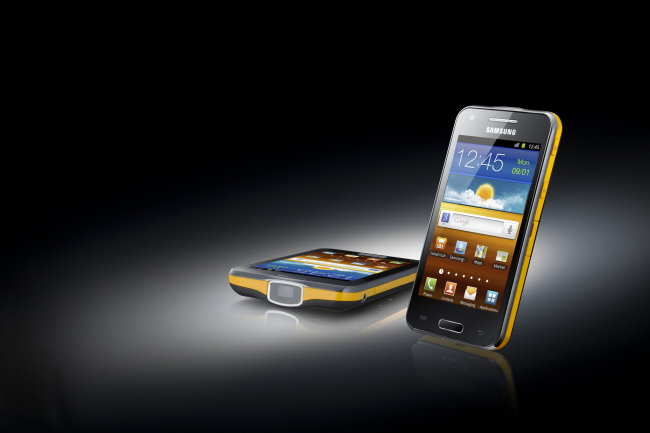The Samsung Galaxy Beam smartphone, with built-in projector
The Samsung Galaxy Beam is perhaps one of the most curious smartphones we’ve ever had the opportunity to review. To begin with – its unique selling point, really – it has a cinema projector capable of beaming high-definition movies up to 50 inches wide onto a wall.
When I was at Mobile World Congress earlier this year in Barcelona, Spain, a few things were apparent. Two years previously, the buzz was all about smartphones, but in 2012 suddenly every stand was studded with displays from smartphones to tablets; mostly tablets. The problem with that vibe is that it all gets a bit samey and you find yourself embarking on a mystery quest for something that has the wow factor.
I found it for sure when I saw the novel Galaxy Beam on Samsung’s stand. The very notion of beaming your content appealed to my inner Star Wars geek (think R2-D2) and it’s something that I think will create quite a stir.
It is very much an indicator to the future where built-in projectors will be as commonplace as cameras are on phones, tablets or laptops today. It is predictable really that the phones (and computers) of the future won’t just beam content onto surfaces, they will also beam interactive keyboards onto surfaces. Imagine walking around in a couple of years with a pen-like device that is as powerful as a supercomputer doing all of that?
Well that’s the future and this is now and the Beam is an impressive piece of kit.
“Holy s—,” was my fiancée’s response when I beamed a movie trailer onto our living-room wall.
Display
The device itself has a 4-inch 480 x 800 WGVA (TFT) screen and it is powered by a 1GHz dual-core processor.
The 15 lumens projector allows you to beam the contents of your smartphone onto a surface at up to 50 inches. In effect you can watch high-definition (well, up to 780p) movies anywhere without having to have a 50-inch TV.
One of the cool features of the phone is it can detect if you are watching a video and while you may be holding the device in portrait mode it will beam the content in landscape mode onto the surface.
One of the incredible and unsung capabilities of the device is the audio – you don’t have to worry about speakers or headphones so much because the speakers on the Beam are rather excellent.
The device also boasts 8GB of internal memory, which is pretty decent for multimedia storage.
Beaming video onto the wall (either 480p or 780p) via a smartphone is an incredibly satisfying experience (don’t ask me why) and to really get the best experience make sure you are beaming onto a blank surface in low-light conditions.

Battery
Predictably, using the projector does drain battery life and Samsung’s Beam has to be the first phone I’ve ever reviewed that comes with two batteries. Thoughtfully, Samsung has also included an external charging device for the other battery.
But despite any fears for discontent over the likely drain of a battery through using a projector, the 2000 mAh battery is perfectly adequate for all the other tasks you would use the phone for.
To use the projector, you can either click on the app or make use of a side button to the top right of the device. Keeping your finger on the button activates the projector and you are instantly presented with a home screen with a slider that allows you to adjust the focus or rotate the screen and it even comes with a Quickpad app that lets you draw onto the screen, use your finger as a pointer, etc. Seriously, expect to see this capability become commonplace in smartphones, tablets and laptops in the coming years.
Conclusion
The smartphone itself is slick in many ways but owes more to the Samsung Galaxy II in its makeup than its top-selling sibling, the Galaxy S III.
On its own merits, the Samsung Beam is a stylish smartphone that runs on Android 2.3 (Gingerbread). With its distinctive mustard and Chrome body it is capable of turning heads, but put it beside the Samsung Galaxy S III which is slimmer and has a more contemporary user interface and a better camera, and only then does it feel a little jaded.
It is also a bit bulkier in order to accommodate the 15 lumens projector.
That said, it is the latest in a series of novel devices that Samsung is bringing to the market that include the large-screen Samsung Galaxy Note and illustrate the hard work that is coming to fruition from the R&D labs.
Samsung is at the start of an interesting journey with projector technology which one day may be commonplace as a way of sharing content.
The Samsung Beam definitely has the wow factor despite coming in a slightly dated chassis, possessing a 5MP camera when 8MP is now standard, and being based on Android Gingerbread rather than Ice Cream Sandwich (2.4).
The fact Samsung has managed to pack a 15 lumens projector into a perfectly good smartphone and still maintain a compact appearance (it measures just 12.5mm thick) is commendable.
The Samsung Galaxy Beam ranges from free on the Vodafone MyWay Complete Plus plan at €65 per month.